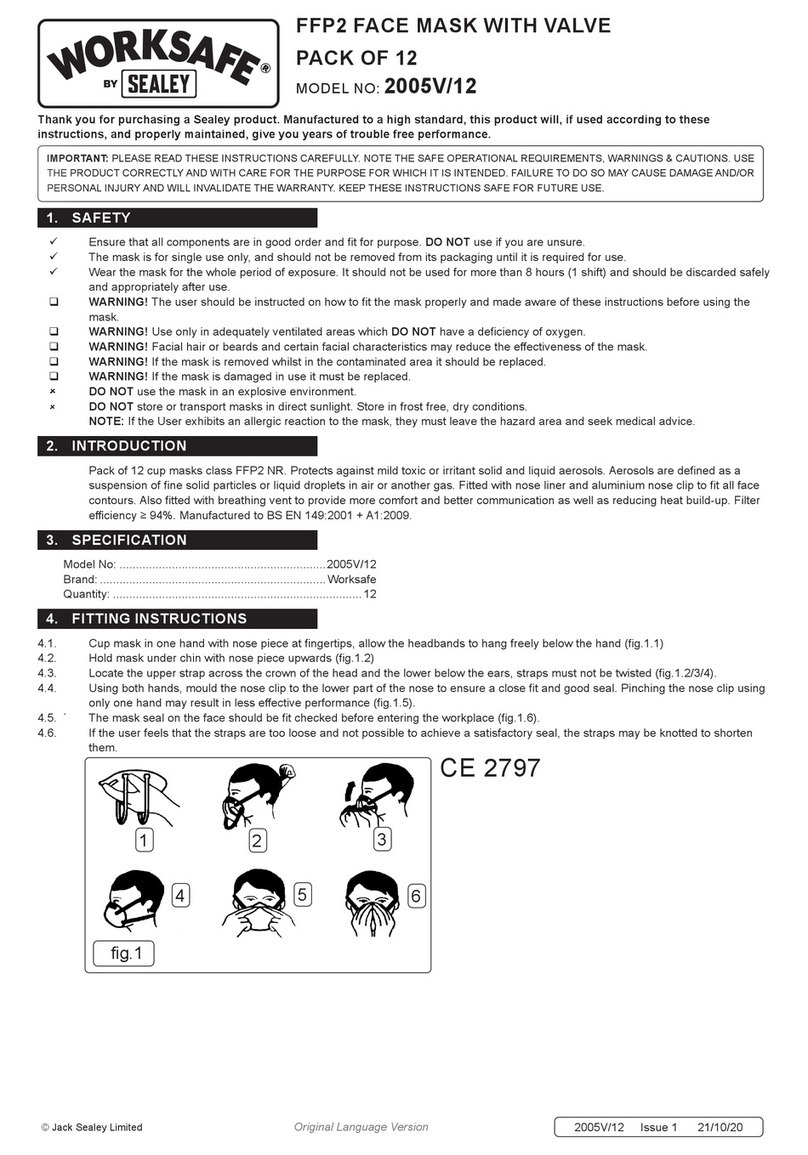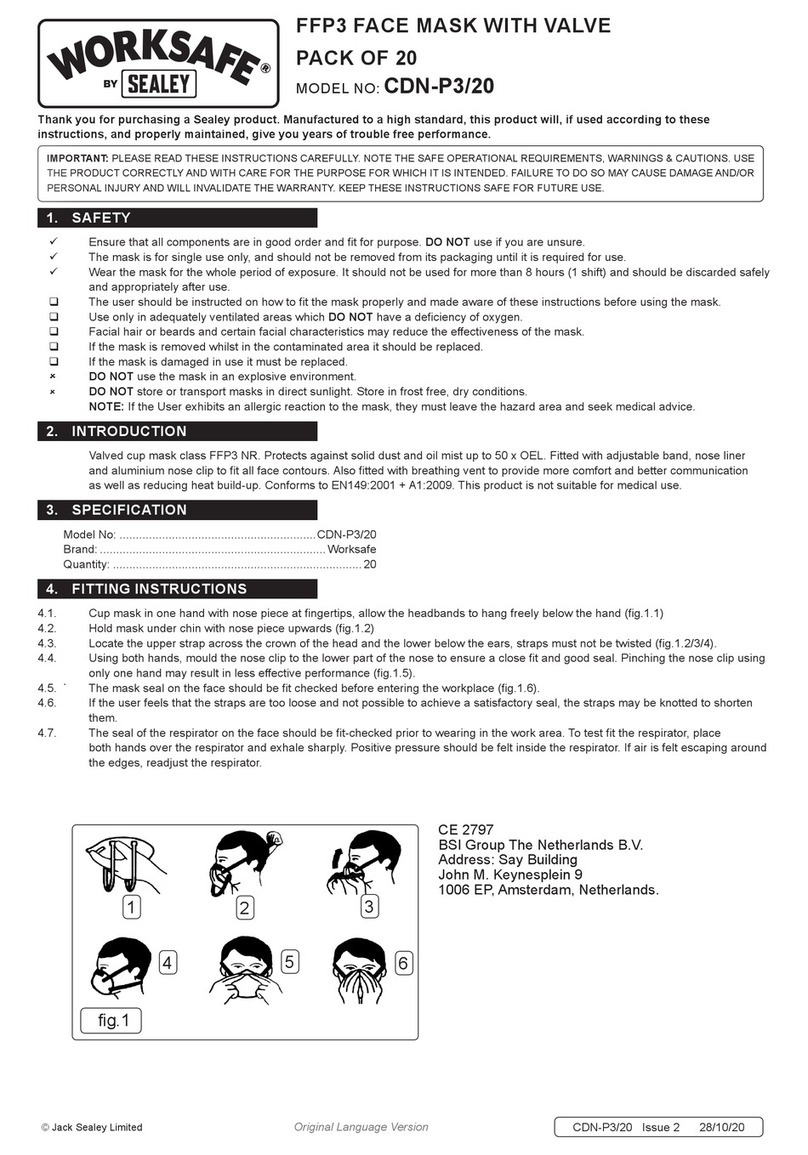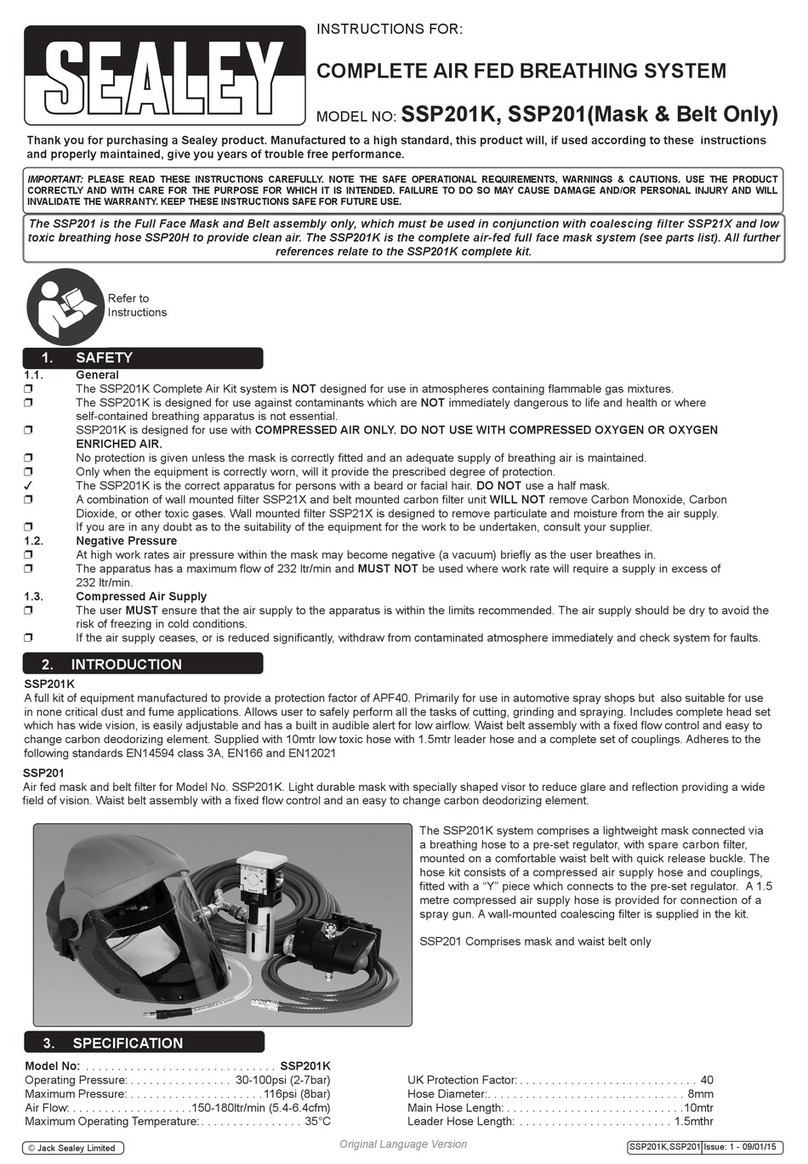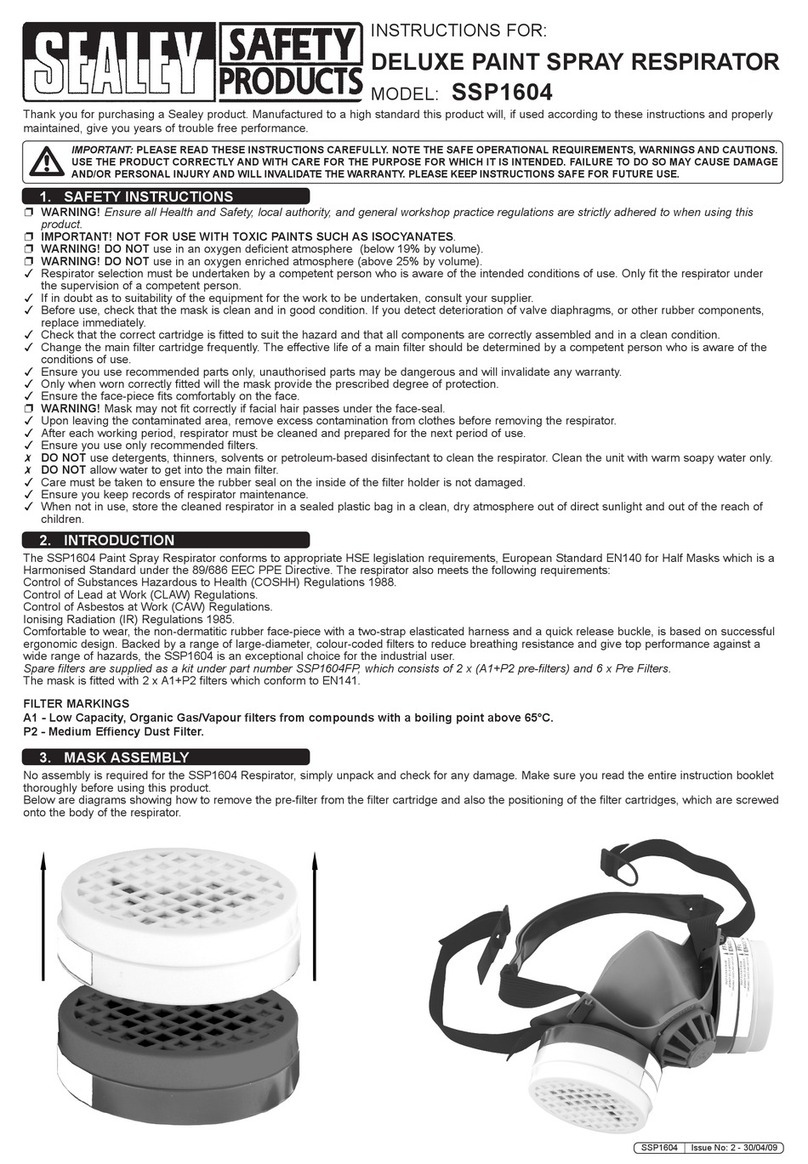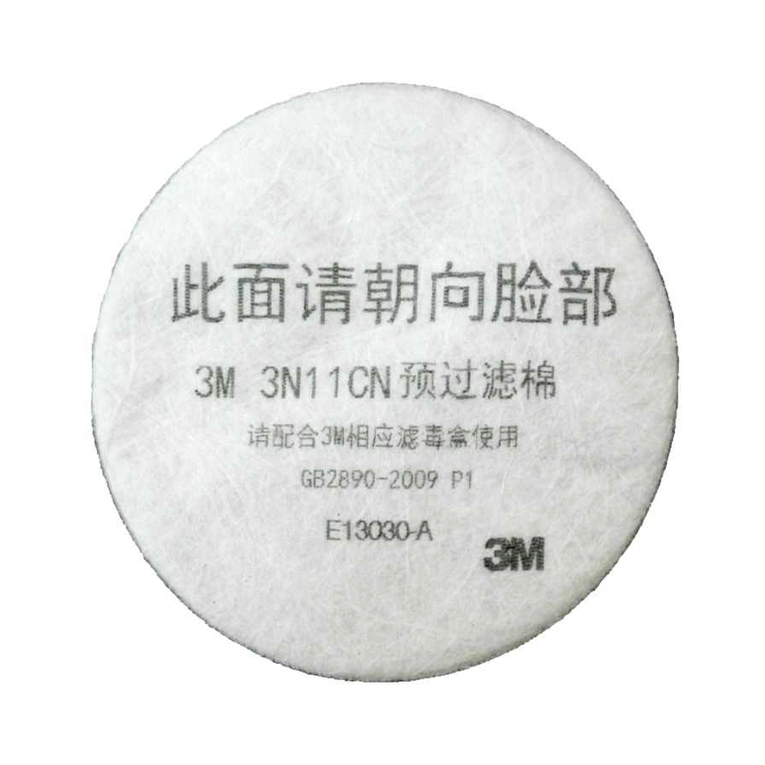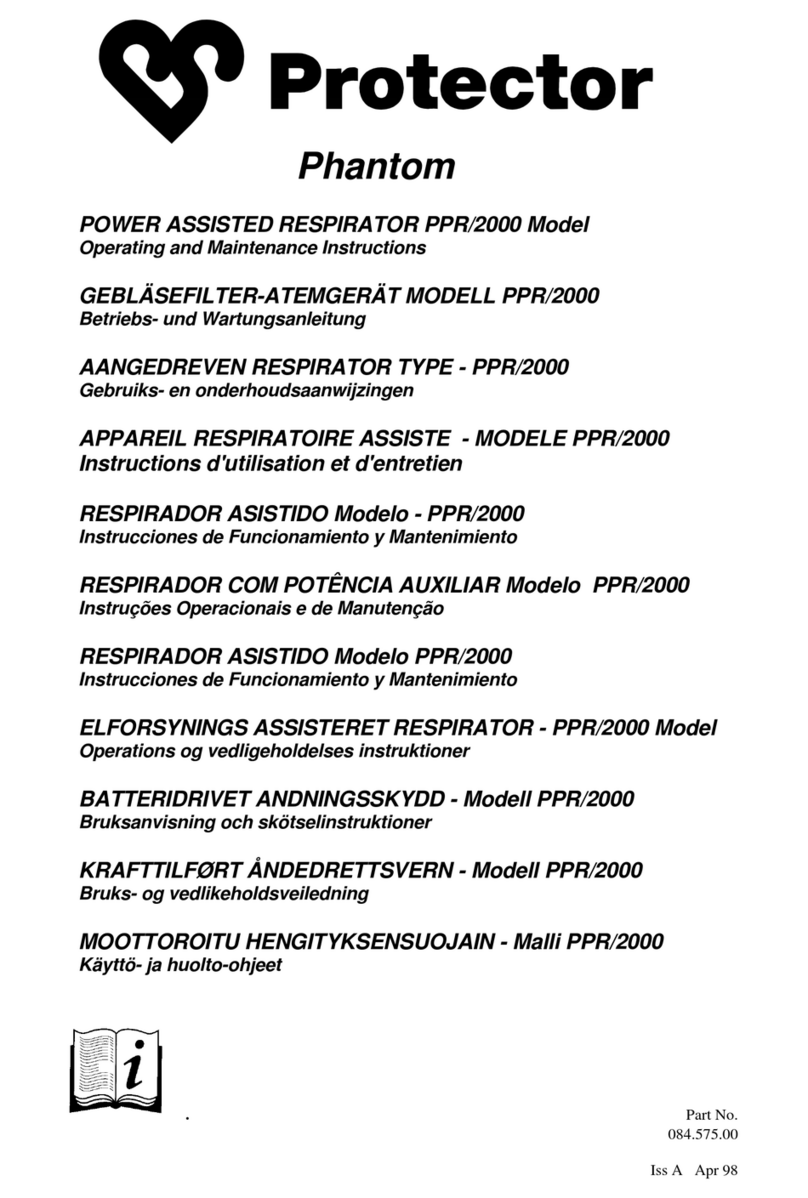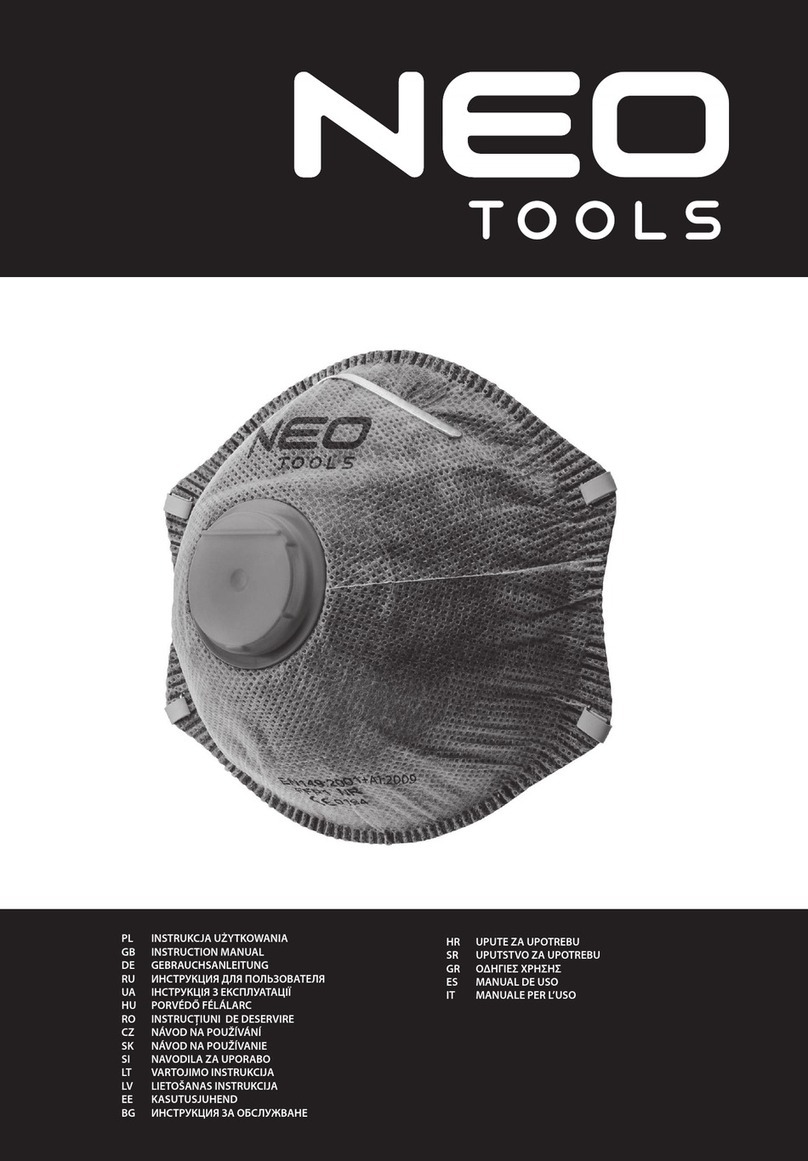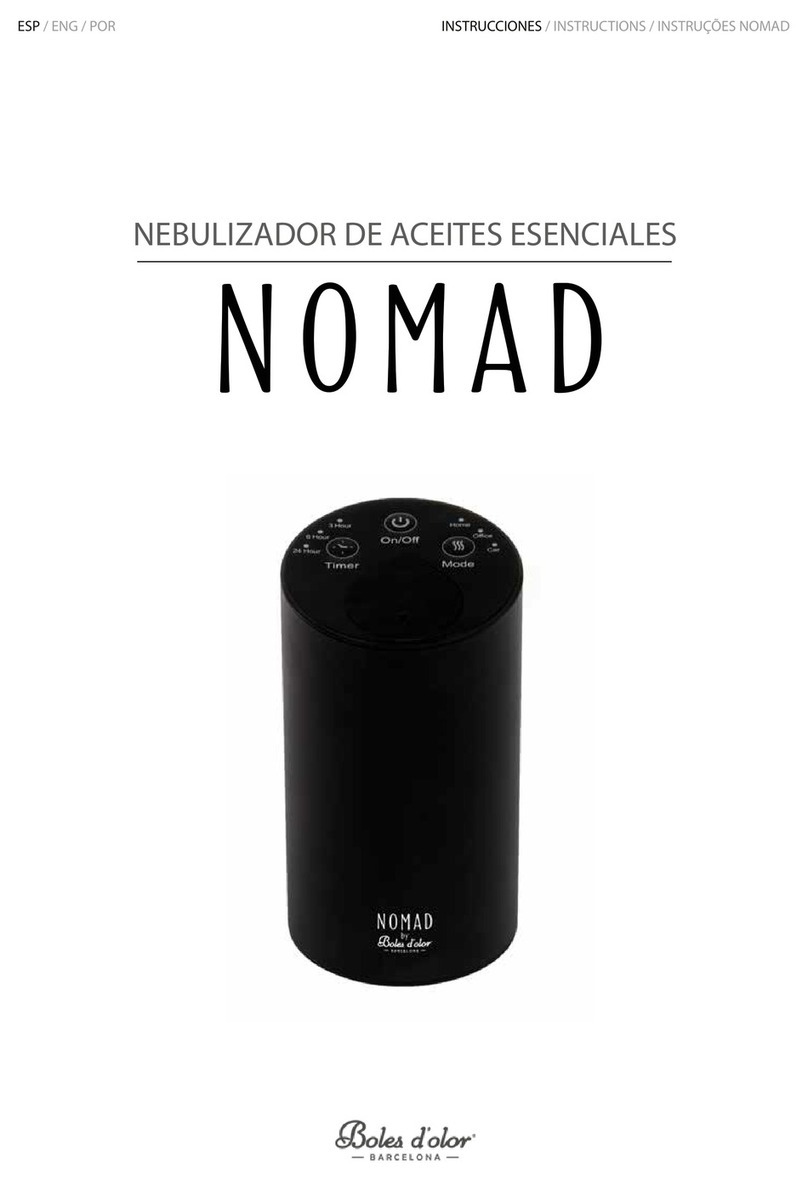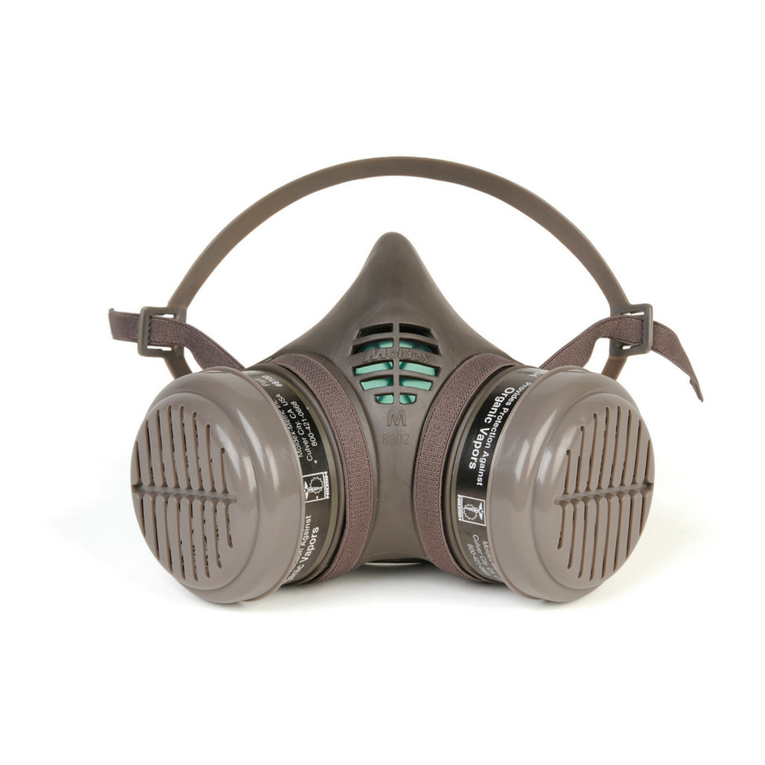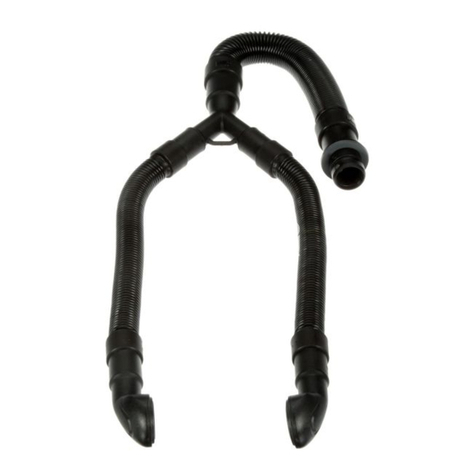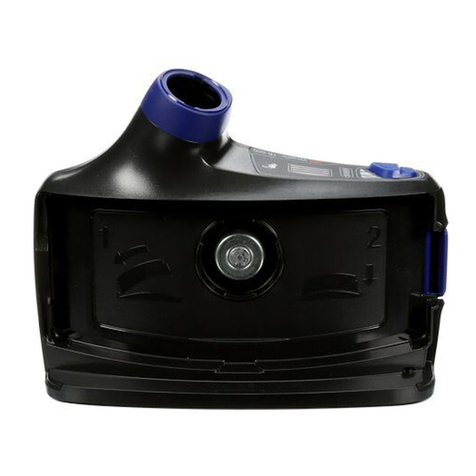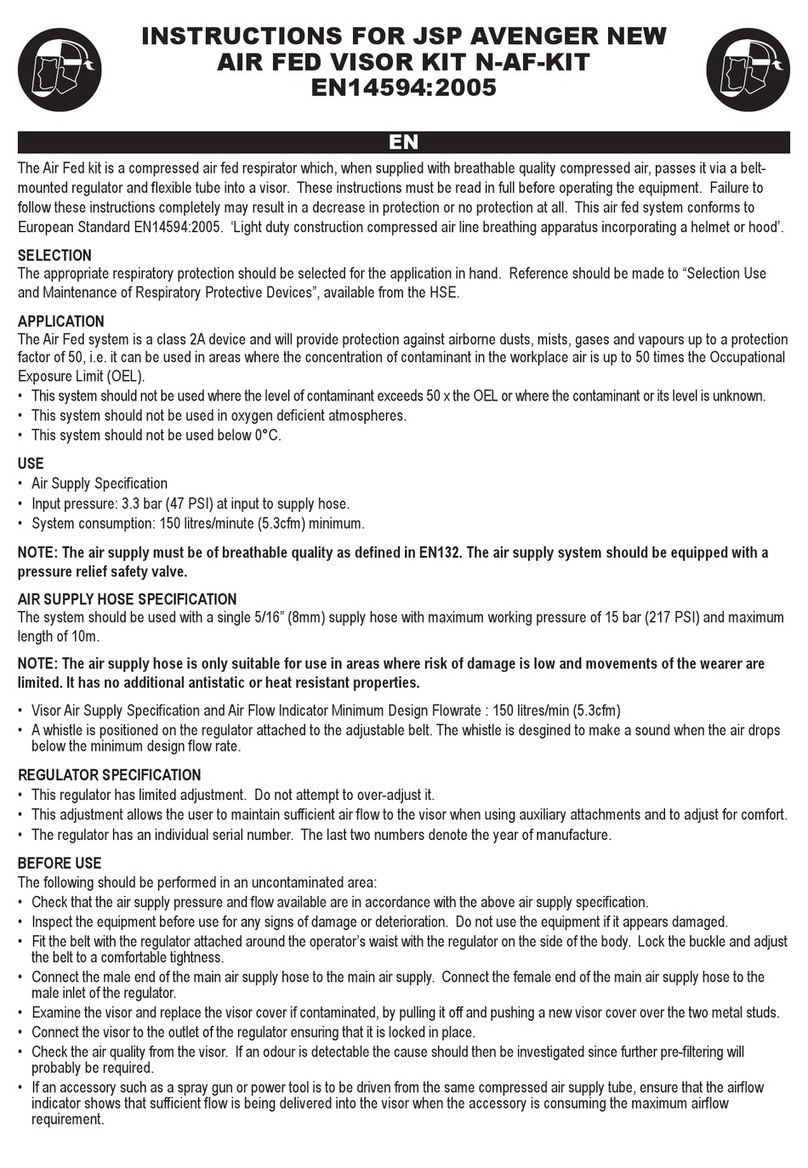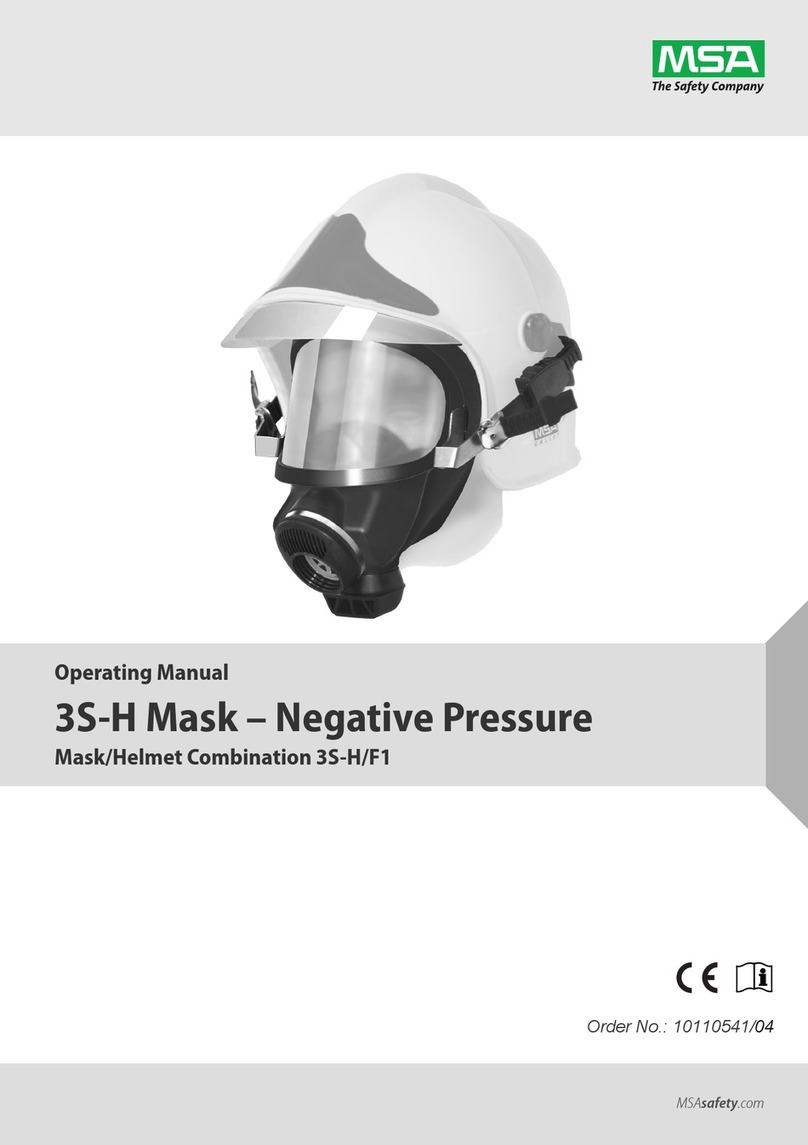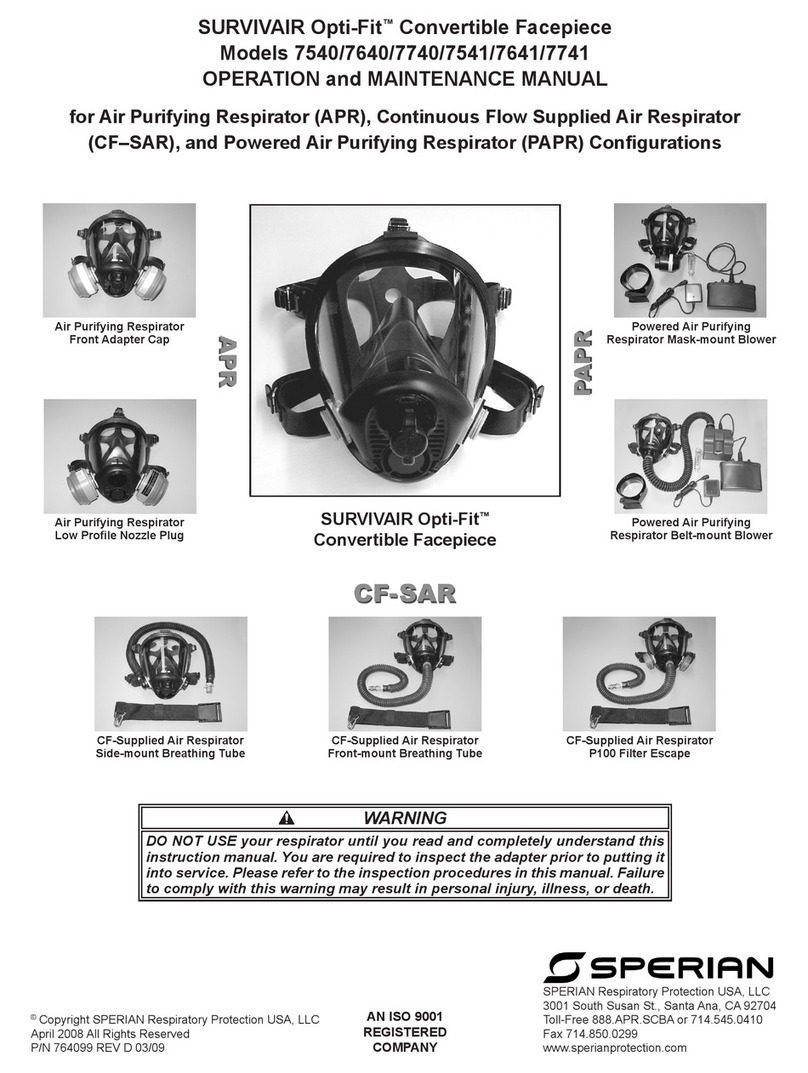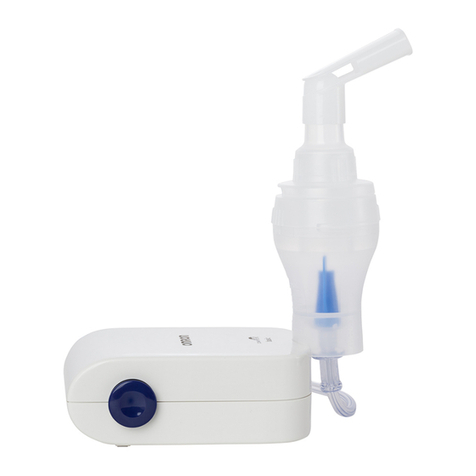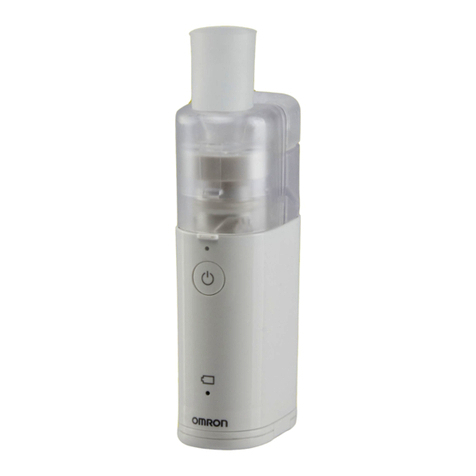Sealey SSP1698 User manual

pWARNING! Ensure all health and safety, local authority, COSHH, and general workshop practice regulations
are strictly adhered to when using this product.
pWARNING! DO NOT use in an oxygen deficient atmosphere (below 17% by volume).
pWARNING! DO NOT use in an oxygen enriched atmosphere (above 25% by volume).
pWARNING! DO NOT use against levels of contaminants greater than the protection factor of the
respirator/filter combination multiplied by the Occupational Exposure Limit (OEL) of the contaminant.
pWARNING! DO NOT use this respirator in areas immediately hazardous to life or health.
3AEROSOLS:A1P2 combination filter is type S, and protects against particles and water based aerosols
s
sNOTE: These filters will NOT protect against aerosols based on liquids other than water.
3GAS: Filters are divided into types for use against specific groups of gases and may not protect against
gases other than those within the group for which they are designed. The A1P2 filter is a combination filter
which offers protection against organic gases and dust, (see Chapter 2. Protection Factors).
3All filters are labelled with an expiry date after which they should not be used.
3If packaging of a Combination filter is opened, the filter must be discarded within six months,even if unused.
3The Half Mask does not offer any protection without the appropriated filter installed.
3The filters are only suitable for use between -20OC and +70OC.
3Respirator selection must be undertaken by a competent person who is aware of its intended conditions of use.
3Only fit the respirator under the supervision of a competent person.
3If in doubt as to suitability of the equipment for the work to be undertaken, consult your supplier.
3Before use, check that the mask is clean and in good condition. If you detect deterioration of valve diaphragms
or other rubber components they must be replaced immediately.
pWARNING! DO NOT use or store the respirator with the blanking pad (See fig 2.C.)in place. DO NOT expose
the blanking pad to chlorinated solvents, ketones or aromatic hydrocarbons, either in use or in storage.
3Ensure correct filter is fitted for hazard and all components are correctly assembled and in a clean condition.
3Change the main filter cartridge frequently. The effective life of a main filter should be determined by a
competent person who is aware of the respirators conditions of use, (see Chapter 5).
3Ensure you use genuine parts only, non authorised parts may be dangerous and will invalidate any warranty.
3Only when correctly donned, and worn, will mask provide the prescribed degree of protection.
3Ensure the face-mask fits comfortably on the face.
pWARNING! the user should be clean shaven to achieve correct seal of the face mask. Mask may not fit
correctly if facial hair passes under the face-seal.
pWARNING! If a correct fit cannot be achieved the respirator MUST NOT be used.
3Upon leaving the contaminated area, remove excess contamination from clothes before removing respirator.
3After each working period, respirator must be cleaned and prepared for the next period of use.
7DO NOT use detergents, thinners, solvents or petroleum-based disinfectant to clean the respirator. Clean the
unit with warm soapy water only.
3When cleaning ensure the rubber seal on the inside of the filter holder and valves are not damaged.
7DO NOT allow water to get into the main filter.
3Ensure you keep records of the respirators checks and maintenance (see card included).
3When not in use, store the cleaned respirator in a sealed plastic bag (supplied) in a clean dry atmosphere
out of direct sunlight and the reach of children.
3Filters must be stored in dry conditions avoiding extremes of humidity and temperature.
pWARNING! If valves are removed from mask, they must be discarded, Only NEW valves must be re-fitted.
01284 757500
E-mail:
sales@sealey.co.uk
01284 703534
NOTE: It is our policy to continually improve products and as such we reserve the right to alter data, specifications and component
parts without prior notice. IMPORTANT: No liability is accepted for incorrect use of this equipment. WARRANTY: Guarantee is 12
months from purchase date. proof of which will be required for any claim. INFORMATION: Call us for a copy of our latest catalogue
on 01284 757525 and leave your full name and address including your postcode.
Sole UK Distributor, Sealey Group, Bury St. Edmunds, Suffolk.
INSTRUCTIONS FOR
HALF MASK
RESPIRATOR & FILTERS
Model SSP1698 & SSP1698/FP
Thank you for purchasing a Sealey Product.
Manufactured to a high standard this product will, if
used according to these instructions and properly
maintained, give you years of trouble free
performance.
IMPORTANT:PLEASE READ THESE INSTRUCTIONS CAREFULLY. NOTE THE SAFE OPERATIONAL
REQUIREMENTS, WARNINGS AND CAUTIONS. USE THIS PRODUCT CORRECTLY AND WITH CARE FOR THE
PURPOSE FOR WHICH IT IS INTENDED. FAILURE TO DO SO MAY CAUSE DAMAGE OR PERSONAL INJURY, AND
WILL INVALIDATE THE WARRANTY. PLEASE KEEP INSTRUCTIONS SAFE FOR FUTURE USE.
1. SAFETY INSTRUCTIONS
6. PARTS LIST
Declaration of Conformity We, the sole distributor of Sealey Products in
the UK, declare that the the productslisted below are in conformity with the following
EEC standards and directives. A copy of the CE License for these productsis held by
the Manufacturer and may be inspected by contacting Jack Sealey Ltd
For Jack Sealey Ltd.
Sole distributor of Sealey Power Products
HALF MASK RESPIRATOR & FILTERS Models: SSP1698 & SSP1968/FP
The respirator is manufactured & tested to European Standard EN140
and may be used with A1P2 combination filters to EN141.
Manufacturers ISO9000 Cert No FM22064 EC Type-examination by BSI
London (Notified body No 0086)
1st April 1999
4. Rinse all cleaned items in cold water, gently shake off excess water and allow all parts to dry NATURALLY.
DO NOT apply heat to assist drying.
5. When completely dry, re-fit all components to the face mask in the same manner as they were removed.
5.3. VALVE REPLACEMENT.
Valves should be replaced every two years, or if damaged, or if removed from mask for any reason.
1. Remove the louver covers from each side of the face mask (fig 3.E) to expose and remove exhale valves,
2. Remove the inhale valve from the inside of the face mask.
pWARNING! Only new valves must be fitted to the face mask. Removed valves must be discarded, they
must not be re-used. We recommend you keep spare valves in stock, (see parts list).
3. Handle the new valves very carefully as they must not be stretched or distorted, as this will prevent them
providing a correct seal.
pWARNING! Ensure valves are fitted the correct way around and not damaged in the process.
a) INHALE VALVE (flat): Place the valve on the inside of the mask and pull the stalk of valve through
the mounting hole so that the stalk points out of the mask.
b) EXHALE VALVES (stepped): Place the valves on the outside of the mask against the exhale outlets
and pull the stalks through the mounting holes so that the stalks point into the face mask.
5.4. REPLACEMENT FREQUENCY
Filters . . . . . . . . . . . . . . . .If removed from packing discard within six months even if unused, or if
damaged, or un-serviceable (see 5.1.2. for further information).
Pre-filters . . . . . . . . . . . .Frequent replacement of pre-filters will prolong the life of dust and combination filters.
Valves . . . . . . . . . . . . . . .Every two years, or if damaged, or if removed from mask for any reason.
Face mask . . . . . . . . . . . .Every five years, or if damaged.
5.5. MASK STORAGE
When clean and thoroughly dry, place the respirator
in a strong plastic bag, seal the neck and store in a clean,
dry, safe location out of direct sunlight.
Item Description
1Face mask
2Exoskeleton
3Inhale valve
4Exhale valve
5Upper elastic strap
6Lower elastic strap
7Exoskeleton Retaining ring
8Male neck strap buckle
9Female neck strap buckle
10 Top neck strap buckle
11 Exoskeleton filter seal
12 Side valve cover
Item Description
17 Pre-filter cover
19 Head strap (male)
20 Head Strap (female)
Original Date:- 010499
Issue Date:-
Version Nbr:- 0
Date Modified:- N/A
Signed by Mark Sweetman
SSP1698, SSP1698/FP - 0000 - (2) - 170999

2.1. FILTER PROTECTION FACTORS.
Filter type . . . . . . . . . . . . . . . . . . . .A1P2
Filter Class . . . . . . . . . . . . . . . . . .A1P2s
Label Colour . . . . . . . . . . . . . . . . .Brown/White
Standard . . . . . . . . . . . . . . . . . . . .EN 141
Application . . . . . . . . . . . . . . . . . . .Organic gasses and vapours, particles and water based aerosols.
Laboratory Protection Factor . . . . .Dust = 12. Gas = 50
Assigned Factor . . . . . . . . . . . . . . .Dust = 10
Protection BS4275 . . . . . . . . . . . . .Gas = 10
2.1.1. Protection Factor Selection.
a) The Pre-filters provided with the kit are recommended for use with the A1P2 filter.
b) The above chart details are both Laboratory protection factors and Assigned protection factors.
1. Laboratory protection factors are minimum requirements which have been achieved in the laboratory
during certification testing .
2. Assigned protection factors are the protection factors as detailed by BS4275:1997 which is based on work
piece studies. These suggest that Assigned levels are what could reasonably be achieved by the majority
of persons in the work place who have been correctly trained in fitting, use, and maintenance of mask and filters.
NOTE: We recommended when deciding product suitability the Assigned protection factor is used.
2.2. CONTAMINANT FACTORS.
Dividing the concentration of a contaminant in the work place atmosphere by the Occupational Exposure
Limit (OEL) of that contaminant will show you the minimum Protection Factor required
2.2.1. Example:
Concentration of contaminant X in work place atmosphere = 200PPM Min Protection Factor required = 200 = 8
Occupational Exposure Limit of contaminant X = 25PPM 25
2.3. SELECTION FACTORS.
1. Ensure equipment to be used offers a Protection Factor GREATER than the minimum shown by your calculation.
2. If protecting against particles and gases select a Combination Filter that offers suitable Protection Factors for
both contaminants.
3. If the minimum Protection Factor required is CLOSE to the Protection Factor shown in the chart for a given
Respirator and Filter combination, we recommend the use of equipment offering a higher Protection Factor.
NOTE: For details of OELs and recommendations of filter types for specific contaminants refer the HSE
guide to OELs - EH-40.
The respirator is suitable for use in temperatures between -20OC and +70OC.
2.4. DEFINITION OF TERMS
PARTICLES: . . . . . . . . . . . . . . .Dusts, fibres and fumes.
GASES: . . . . . . . . . . . . . . . . . .Gases and vapours.
LIQUID BASED AEROSOL: . . .Is a suspension of liquid droplets in air.
WATER BASED AEROSOL . .Is one which is produced from a solution and/or a suspension of solid
. . . . . . . . . . . . . . . . . . . . . .materials in water such that the only hazardous component is attributable
. . . . . . . . . . . . . . . . . . . . . . . . .to the solid material.
COMBINATION FILTER . . . . . .A filter that offers protection in different types and classes.
Example: A1P2 filter offers Type A, Class 1 protection against gases & Class 2 protection against particles.
2. PROTECTION FACTORS
3. FILTER FITTING
4. FITTING THE RESPIRATOR
IMPORTANT. Before fitting remove the Blanking pad (or disc, the thin black flexible pad fig a and fig2 item C)
from inside the pre-filter cover. Keep the pad safe for latter use.
1. Check that you have the correct type of filter for the intended application, and check the
filter for signs of damage.
2. Remove any existing filter from the mask by twisting ant-clockwise.
3. Check that the filter seal on the front of the mask is intact and not damaged (fig 1 item A).
4. Remove the Blanking pad (or disc, fig 2.C) from inside pre-filter cover (D), and keep safe for later use, and
lay a pre-filter (B) inside the cover (D).
5. Clip the pre-filter cover (D) onto the main filter (A) and push the cover home.
6. Hold the mask and align the small arrow on the side of the filter connector (fig 2.1.) with the the top of the
masks inlet connector (fig 1.A).
7. Hold the filter flush against the surface of the mask inlet (fig 3), and gently turn clockwise until the filter
cover cross bars are aligned with the mask louvers (fig 4).
Fitting of the respirator must be supervised by a competent person. Before donning
equipment, ensure the correct filter is fitted and that the mask valves are in place,
un-damaged and correctly seated (fig 5. A = Exhale, B = Inhale valve).
1. Remove pre-filter cover take out pre-filter and place to one side for use when mask has been fitted.
2. Hold mask to your face placing the narrow rim over your nose and the wider section onto your chin.
3. Pass the top head harness over your head, and check to ensure it is not twisted.
4. Adjust the head harness to provide a comfortable fit.
5. Take each lower neck straps and place them round the back of your neck and snap together. Adjust the
straps until they fit snugly around the neck.
6.
Take the pre-filter cover (fig 2. D), place the Blanking pad (or disc, fig 2. C), inside the cover and fit to the mask.
7. Lightly inhale so that the air becomes restricted creating a partial vacuum inside the mask.
The mask should now adhere to the face which indicates the mask has been correctly fitted and is sealed.
If the mask fails to adhere correctly, re-adjust the face mask and straps, then repeat 6 above until a
correct fit can be achieved.
pWARNING! If a correct fit cannot be achieved the respirator MUST NOT be used.
8.
When the respirator is correctly fitted to your face, remove the Blanking pad (or disc) from the filter cover and
replace with the pre-filter. Attach the cover back onto the main filter (fig 2.A).
9. If all appropriate instructions have been correctly followed you are ready to proceed with the assigned task.
pWARNING! DO NOT use or store the respirator with the blanking pad in place. DO NOT expose the
blanking pad to chlorinated solvents, ketones or aromatic hydrocarbons, either in use or in storage.
fig 1. fig 2. fig 3. fig 4.
fig 5.
5. CLEANING & MAINTENANCE
IMPORTANT.It is essential that the respirator is kept clean and correctly maintained to ensure it is in efficient
working order. COSHH regulations require maintenance records to be kept. Dates of inspection and replacement
of parts should be recorded on a record card.
5.1. FILTERS
5.1.1. Cleaning & storage.
1. Remove the filter from the mask and the pre-filter cover from the main body.
2. Gently wipe any dust from the casing with a soft dry cloth avoiding contact with filter pads.
3. Store the filter and pre-filter cover in a dry, clean location avoiding extremes of humidity and temperature.
5.1.2. Changing Filters.
1. A competent person will regularly check filters to determine if replacement is required.
a) Dust filters: Change when an increase in breathing resistance is noticed.
b) Gas filters: Change immediately any breakthrough of the contaminant is detected by smell or taste.
2. The A1P2 Combination filter must be changed using either of the above criteria. Actual life of filter is wholly
determined by the individual circumstances in which they are used and is affected by breathing rate, type
of contaminant, concentration of contaminant, circumstances of exposure, and many other factors.
3. Frequent replacement of pre-filters will prolong the life of dust and combination filters.
NOTE: If working with gaseous contaminants with an odour threshold below the OEL, or for users with an
impaired sense of smell, use Air Fed breathing equipment. We recommend our SSP200K and SSP25K.
5.2. FACE MASK.
1. Prepare a mild soapy warm water wash with a 1-10 (10%) dilution of TCP antiseptic solution.
DO NOT use detergents, thinners, solvents, petroleum, or other disinfectants.
2. Check that the filter has been removed, then remove the louvers valve covers and head straps
(DO NOT REMOVE THE VALVES).
3. With a soft clean (lint free) cloth, use the prepared wash to swab the components ensuring you clean
both the inside and the outside of the face mask. NOTE: Take great care to avoid damage to the valves.
E
fig a.
SSP1698, SSP1698/FP - 0000 - (2) - 170999
This manual suits for next models
1
Other Sealey Respiratory Product manuals
